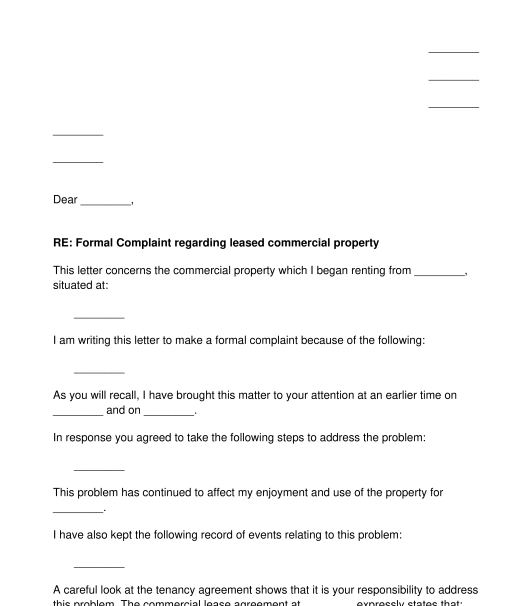 02/09/2025
02/09/2025

Answer a few questions and your document is created automatically.

Your document is ready! You will receive it in Word and PDF formats. You will be able to modify it.

 02/09/2025
02/09/2025
 Word and PDF
Word and PDF
 1 page
1 page
A formal complaint to a landlord is a formal letter sent by a tenant of a commercial property to the landlord or letting agent of the property, letting them know of issues affecting the commercial property in England and Wales. An example of where a formal complaint can be used is when a business rents a warehouse from a commercial landlord, but notices leakage in the building's drainage that is causing damage to the goods stored in the warehouse. The tenant can use a formal complaint to inform the landlord of this problem and request for a repair.
No, strictly speaking, it is not mandatory to make a written formal complaint to the landlord. However, it is recommended to do so, especially when there is a commercial lease in place. This is because the lease will usually require the tenant to make complaints to the landlord in writing.
Before making a formal complaint to the landlord, there should be a problem with the property that either the tenant cannot fix themselves or is the landlord's duty to fix. An example of this kind of damage includes pipe leakage or structural defects in the building.
The formal complaint should be sent by a business using the property for its commercial operations. This means the tenant can be a sole trader, a partnership, an LLP or even a limited company.
The complaint can also be made to either the landlord or the letting agent responsible for managing the property.
Once the letter of formal complaint has been completed, it should be signed by the tenant. Where the tenant is a company, it should be signed by the person authorised to act on behalf of the company (e.g. CEO, Operations Manager). After which, it should be sent to the landlord or the letting agent either by post or by email. The tenant should also keep a copy of the letter for their own records.
The following documents can be attached to a formal complaint to the landlord:
No, it is not necessary to have a witness for a formal complaint to a landlord. This is because it is a letter and not an agreement.
The formal complaint must contain:
The applicable law for this document is the Landlord and Tenant Act 1954.
You fill out a form. The document is created before your eyes as you respond to the questions.
At the end, you receive it in Word and PDF formats. You can modify it and reuse it.
A guide to help you: How to Send a Letter
Country: United Kingdom